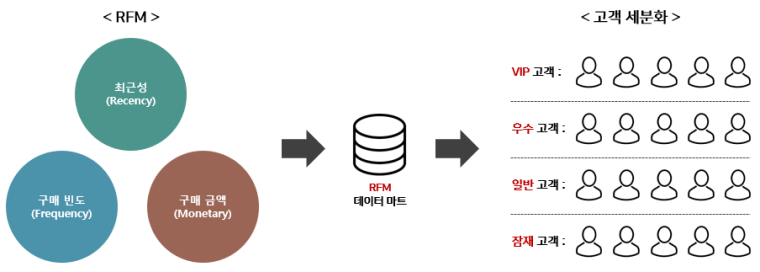1. RFM 분석의 3가지 지표 집계하기
- Recency: 최근 구매일 - 최근에 구매하였는가?
- Frequency: 구매 횟수 - 얼마나 자주 구매하였는가?
- Monetary: 구매 금액 합계 - 얼마나 돈을 썼는가?2. 원리는 아래의 사진과 같다
3. 순서대로 진행 !
1
- 먼저 집계 테이블을 구하는데 위에 분류된 기준을 사용해 컬럼을 생성해준다.
select customer_id,
count(customer_id) as frequency,
sum(sales) as monetary,
max(order_date) AS recent_order
from records
group by customer_id2
- 그다음 나이브하게 5등분으로 나누어 준다.
- 위에서 만든 테이블은 CTE 형식으로 나타내어 주어도 좋지만 서브쿼리를 사용하여 나타내어 본다.
SELECT customer_id,
ntile(5) OVER ( ORDER BY recent_order ) AS rfm_recency,
ntile(5) OVER ( ORDER BY total_orders ) AS rfm_frequency,
ntile(5) OVER ( ORDER BY total_sales ) AS rfm_monetary
from(select customer_id,
count(customer_id) as total_orders,
sum(sales) as total_sales,
max(order_date) AS recent_order
from records
group by customer_id) as t- 결과 테이블
.png)
3.
RFM CELL 을 만들어 준다.
/* cte */
WITH preprocessing_tbl
AS (
/* 5등분한 테이블 */
SELECT customer_id,
Ntile(5)
OVER (
ORDER BY recent_order ) AS rfm_recency,
Ntile(5)
OVER (
ORDER BY total_orders ) AS rfm_frequency,
Ntile(5)
OVER (
ORDER BY total_sales ) AS rfm_monetary
/* RFM 을 계산한 테이블 */
FROM (SELECT customer_id,
Count(customer_id) AS total_orders,
Sum(sales) AS total_sales,
Max(order_date) AS recent_order
FROM records
GROUP BY customer_id) AS tbl1)
/* RFM CELL 만들기 */
SELECT customer_id,
rfm_recency,
rfm_frequency,
rfm_monetary,
Concat(rfm_recency, rfm_frequency, rfm_monetary) AS rfm_cell
FROM preprocessing_tbl- 서브쿼리 버전
/* 서브쿼리 */
SELECT customer_id,
rfm_recency,
rfm_frequency,
rfm_monetary,
Concat(rfm_recency, rfm_frequency, rfm_monetary) AS rfm_cell
FROM (
/* 5등분한 테이블 */
SELECT customer_id,
Ntile(5)
OVER (
ORDER BY recent_order ) AS rfm_recency,
Ntile(5)
OVER (
ORDER BY total_orders ) AS rfm_frequency,
Ntile(5)
OVER (
ORDER BY total_sales ) AS rfm_monetary
/* RFM 을 계산한 테이블 */
FROM (SELECT customer_id,
Count(customer_id) AS total_orders,
Sum(sales) AS total_sales,
Max(order_date) AS recent_order
FROM records
GROUP BY customer_id) AS tbl1) tbl2- 결과 테이블
.png)
- 구분기준
| Cannot lose | Active fans | Promising newbies | Potential churners | |
|---|---|---|---|---|
| RFM cell values | 355, 255 | 543, 542, 453, 452 | 525, 524, 515, 514 | 335, 334, 325, 324 |
| Conditions for inclusion | Low RHigh F&M | High R&FLow M | High R&MLow F (so far) | Mid RLow FHigh M |
| Description | Big spenders who haven’t purchased lately | Customers who buy often & recently, but at low price points | New customers with large orders | High spending customers who haven’t purchased often or lately |
최종버전
/* 구분 기준별 나누기 */
SELECT customer_id,
rfm_recency,
rfm_frequency,
rfm_monetary,
rfm_cell,
CASE
WHEN rfm_cell IN ( '355', '255' ) THEN
'Cannot lose'
WHEN rfm_cell IN ( '543', '542', '453', '452' ) THEN
'Active fans'
WHEN rfm_cell IN ( '525', '524', '515', '514' ) THEN
'Promising newbies'
WHEN rfm_cell IN ( '335', '334', '325', '324' ) THEN
'Potential churners'
ELSE 'Other'
END AS rfm_segment
FROM (
/* 서브쿼리 - RFM cell 만들기 */
SELECT customer_id,
rfm_recency,
rfm_frequency,
rfm_monetary,
Concat(rfm_recency, rfm_frequency, rfm_monetary) AS rfm_cell
FROM (
/* 5등분한 테이블 */
SELECT customer_id,
Ntile(5)
OVER (
ORDER BY recent_order ) AS rfm_recency,
Ntile(5)
OVER (
ORDER BY total_orders ) AS rfm_frequency,
Ntile(5)
OVER (
ORDER BY total_sales ) AS rfm_monetary
/* RFM 을 계산한 테이블 */
FROM (SELECT customer_id,
Count(customer_id) AS total_orders,
Sum(sales) AS total_sales,
Max(order_date) AS recent_order
FROM records
GROUP BY customer_id) AS tbl1) tbl2) AS tbl3- 결과 테이블 및 시각화
.png)
.png)
위와 같이 고객을 나이브하게 나누어 분류해보았다.
결론
✔️- Cannot lose 고객은 브랜드 홍보대사가 되기 위한 초대장을 보낼 수 있다. (프리미엄을 주는 것)
- 유망한 뉴비 고객군에게는 이전 구매를 보완해주는 추천제품이 포함된 팔로잉 이메일을 보내는 방법을 쓸 수 있다.
- 이밖에 R, F, M 점수가 (1,5,5)인 고객은 과거 프리미엄 고객이었지만 경쟁사에 빼앗겼을 가능성이 높다. 따라서 기능에 대한 강조 또는 쿠폰과 같이 경쟁사와 차별화되는 리워드를 통해 다시 방문할 수 있도록 유도하는 것이 필요하다.
- (1,1,1) 고객은 Recency, Frequency, Monetary 모두 낮다 따라서 이 고객 그룹은 이탈 고객 또는 휴면 고객으로 분류할 수 있다.
- 위 그림을 보면 쉽게 이해할 수 있겠지만 R,F,M 점수가 (5,5,5), 즉 자주 구매하면서 동시에 최근에 구매한 이력이 있고 평균구매액이 높은 고객은 Best 고객으로 분류할 수 있다.
- R, F, M 점수가 (5, 1, 5)인 고객은 신규 가입자이며 구매 금액이 큰 만큼 우량 고객이 될 가능성이 높다. 따라서 이들의 편의성을 높이기 위해
노력 혹은별도 DM을 통해 향후 우량 고객이 될 수 있도록 유인책을 제공하는 것이 필요하다.
참고링크
How to Create RFM Segments for Shopify
- 추가 분석 방향
-
more sophisticated RFM clustering using a K-means model
-
고객이 시간이 지남에 따라 한 셀에서 다른 셀로 이동하는 방법 모색하기
-
LRFM - length 추가
- K means 클러스터링을 통해서 분류해보기
-

